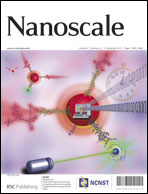Controlling nickel nanoparticle size in an organic/metal–organic matrix through the use of different solvents†
Abstract
Nickel nanoparticles have been created in an organic-based matrix by the reaction of Ni(COD)2 (COD = 1,5-bis-cyclooctadiene) and 2,3,5,6-tetrafluoro-7,7,8,8-tetracyanoquinodimethane (TCNQF4). The size of the nickel nanoparticles can be controlled by the use of different solvents and inclusion of tetrahydrofuran (THF) within the reaction to stabilise the Ni(0) atoms from the Ni(COD)2. Materials are characterised with a combination of X-ray diffraction, electron microscopy and magnetometry and it is found that samples made using a halocarbon solvent resulted in clustered bulk Ni particles (size ≤ 10 nm) with anomalously high superparamagnetic blocking temperatures. Using an isocyanide solvent produces smaller (size ∼ 1 nm), well dispersed particles that show little evidence of superparamagnetic blocking in the range of temperatures investigated (>2 K). In all samples there is another component which dominates the magnetic response at low temperatures and shows an interesting temperature dependent scaling behaviour when plotted as M vs. B/T which we believe is related to the organo-metallic matrix that the particles are trapped within. We propose that the enhanced blocking temperature of particles synthesised using halocarbon solvents can be attributed to inter-particle dipolar interactions and nanoparticle–matrix exchange interactions.


 Please wait while we load your content...
Please wait while we load your content...